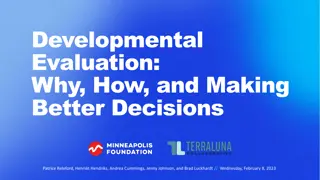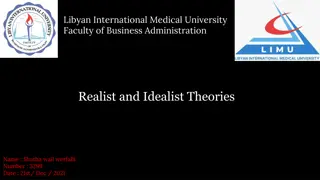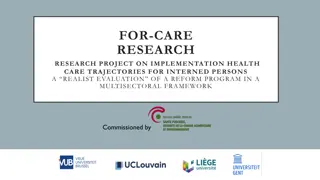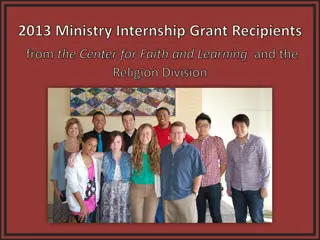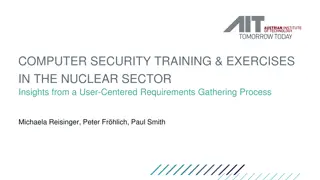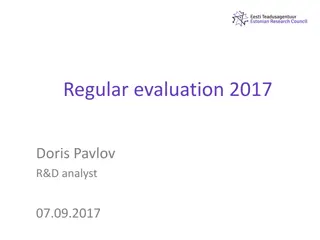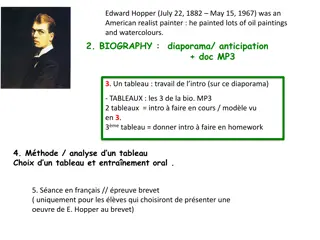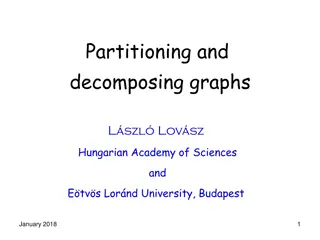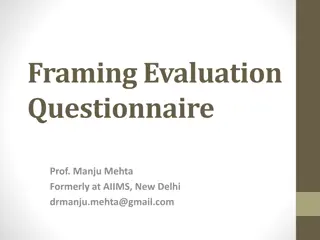Understanding Demi-Regularity in Realist Evaluation
Realist Evaluation is a theory-driven approach focusing on understanding the context and mechanisms of action behind policies and interventions. This webinar explores the concept of demi-regularity in realist evaluation, its origins, and its application in analyzing complex evidence. Key aspects covered include the distinction between programme strategy and mechanisms and how people are the drivers of change in interventions. The session aims to provide insights into the relationship between demi-regularity and realist evaluation through illustrations and discussions led by Justin Jagosh, Ph.D., Director for the Centre for Advancement in Realist Evaluation and Synthesis (CARES).
Download Presentation

Please find below an Image/Link to download the presentation.
The content on the website is provided AS IS for your information and personal use only. It may not be sold, licensed, or shared on other websites without obtaining consent from the author. Download presentation by click this link. If you encounter any issues during the download, it is possible that the publisher has removed the file from their server.
E N D
Presentation Transcript
CECAN Webinar: Demi-Regs and the Characteristics of Realist Evaluation Thursday 5thDecember 2019, 16:00 - 17:00 GMT Presenter: Justin Jagosh, Director for the Centre for Advancement in Realist Evaluation and Synthesis (CARES) Welcome to our CECAN Webinar. All participants are muted. Only the Presenter, Justin Jagosh and CECAN Chair, Gail Deason, can speak. The webinar will start at 4pm GMT. Justin will speak for around 45 minutes and will answer questions at the end. Please submit your questions at any point during the webinar via the question box in the Zoom webinar control panel. Today s webinar will be recorded and made available on the CECAN website. E Mail: cecan@surrey.ac.uk Web: www.cecan.ac.uk www.facebook.com/CECANEXUS Twitter: @cecanexus
Demi-Regs and the Character of Realist Evaluation PRESENTER: JUSTIN JAGOSH, PH.D CENTRE FOR ADVANCEMENT IN REALIST EVALUATION AND SYNTHESIS WWW.REALISTMETHODOLOGY-CARES.ORG FOR: CENTRE FOR COMPLEXITY ACROSS THE NEXUS (CECAN) DECEMBER 5, 2019
Session Objectives: Session Objectives: -To understand the origins and definition of the demi-regularity concept; -To understand how the concept of demi-regularity relates to realist evaluation; -To illustrate the use of demi-regularity in realist analysis.
Realist Evaluation is a theory-driven approach to evaluation and synthesis; used to assess complex evidence the implementation of policy, programmes, services and interventions; concerned with understanding context in relation to underlying mechanisms of action.
Realist Evaluation: Addresses the questions: what works, for whom, under what circumstances and how? (as opposed to does it work ?) Theorizes programmes, policies, interventions and services Asserts that it is not interventions that create change, rather, people create change (Pawson and Tilley 1997) Defines mechanism as how people respond to resources; Distinguishes programme strategy from mechanisms. (They are related, but not the same thing)
The Context-Mechanism-Outcome Configuration From: Jagosh (2019) Realist Synthesis for Public Health: Building an Ontologically Deep Understanding of How Programs Work, For Whom, and In Which Contexts. Annual Review of Public Health: Vol. 40 Adapted from Pawson, R & Tilley N (1997) Realistic Evaluation. Sage: London
Iceberg Metaphor Explaining Ontological Depth From: Jagosh (2019) Realist Synthesis for Public Health: Building an Ontologically Deep Understanding of How Programs Work, For Whom, and In Which Contexts. Annual Review of Public Health: Vol. 40
Demi-Regs: Semi-predictable patterns From: Jagosh et al, 2012. Uncovering the Benefits of Participatory Research. Milbank Quarterly Demi regularity means semi predictable patterns ... The term was coined by Lawson (1997), who argued that human choice or agency manifests in a semi predictable manner semi because variations in patterns of behavior can be attributed partly to contextual differences from one setting to another.
Understanding Demi-Regularity Search for enduring universals Search for idiosyncratic particulars Positivism Realism Constructivism Search for demi-regs Inspired by: Sayer, A (2000). Realism and Social Science, Sage: London
Demi-Regs: Partial event regularities From: from RAMESES I Training Manual (2013). Accessed from www.ramesesproject.org Lawson s interest was with long term social and economic change. He was concerned to distance realism from the idea that there are laws of social evolution and from the alternative that there is nothing but patternless fluctuation. This perspective sits comfortably with the realist notion of program effectiveness. What should not be anticipated is the discovery of intervention panaceas, nor will outcomes be completely haphazard. There will be some patterning. We should be able to discern broad lessons on for whom, in what circumstances and in what respects an intervention is more likely to succeed and these demi regs are the basis for decision support in the policy making process.
Demi-Regs: Partial event regularities From: Lawson, T. (1997) Economics and Reality. Routledge: Abingdon A demi-regularity, or demi-reg for short, is precisely a partial event regularity which prima facie indicates the occasional, but less than universal, actualization of a mechanism or tendency, over a definite region of time-space (p. 204) The patterning observed will not be strict if countervailing factors sometimes dominate or frequently co-determine the outcomes in a variable manner. But where demi-regs are observed there is evidence of relatively enduring and identifiable tendencies at play (p. 204).
Outlier: a data point that differs significantly from other observations From a realist perspective, the concept of an outlier looses relevance when the underpinning mechanism for a so-called outlier is uncovered. Although patterns exist, everything in the social world is underpinned by mechanisms that are triggered in contexts, whether or not a given observation is a common occurrence or a rarefied incident. Therefore, through an ontologically deep understanding of events, demi-regs replace the concept of outliers as a way to explain patterns and variation.
Demi-Regs: three important facets Patterns + Fluctuations: Engaging with demi-regs is to assume that there will be patterns along with fluctuations to those patterns in social reality. Fluctuations are not simply outliers . Relative, Partial Endurance: Demi-regs assume that in the manifested world, events have relative, partial endurance. Apart from the laws of meta-physics, everything that manifests is shaped by the conditions of manifestation. Events do endure, but even that endurance is temporary and partial. Ontologically Deep Outcome Patterns : Whereas regularities pertain to observable, measurable events alone, demi-regs pertain to such events but incorporate the underpinning mechanisms and contexts of their activation.
Using Demi-Regs in Pawson and Tilley s Realist Evaluation : multiple CMO configurations in a pattern Demi-Regularity Typically, [xyz happens], but not always
Demi-Reg Example: In the context of mental health service provision: Typically, when clinicians engage in a partnership approach with the families of people who experience poor mental health outcomes (e.g., clinical depression, anxiety, PTSD), such shared decision-making leads to improved recovery due to the enhanced social support structure. Context: Mental health issues are complex, and exacerbated by misunderstanding, taboo, and isolation Mechanism: By involving families in shared decision-making (resource), people in the social support structure can realize how to better support their family member in crisis (response) Outcome: Improvements in co-ordination of care, improvements in mental health indicators; strengthened family relationships, preventing relapse.
In Conclusion Demi-regs are semi-predictable outcome patterns; Demi-regs have relative, partial endurance; Finally, using demi-regs in a realist evaluation is not essential, however understanding the concept may help to strengthen the analytical process using CMO configurations. Time for questions














